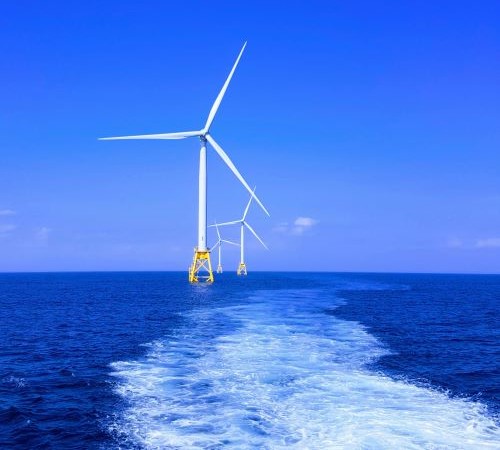Engineering X chairs End-of-Life Committee launched by World Forum Offshore Wind (WFO)
The End-of-Life (EoL) Committee was launched in September 2025 in response to an Engineering X priority recommendation that emerged from an international workshop.
- The new WFO EoL Committee will address the growing global need for safe, sustainable life-cycle design, late-life management and decommissioning in offshore wind.
- Taking a systems approach and a strong global equity lens, the Committee will foster knowledge exchange, align and coordinate existing EoL initiatives, and bridge the gap between policy and industry internationally.
- The EoL Committee will be co-chaired by Dr Anne Velenturf and Lorna Bennet on behalf of Engineering X, a growing collaboration that promotes the role of engineering in tackling safety and sustainability challenges.
The Challenge
Offshore wind energy is a critical pillar in the global transition to renewable energy systems. While the surge in offshore wind is providing much needed green energy, this growth also bears some potential challenges. One of these is increasing safety at the end of life of a growing number of wind turbines in harsh offshore conditions.
With an increasing number of offshore wind turbines set to reach the end of their operational life in the coming years, complexities are set to arise in dismantling and disposing of them safely and sustainably. We have seen in other industries like oil & gas and shipping, that a lack of end-of-life safety management can have significant consequences for humans and the environment. We now have an opportunity to learn from the past and mitigate potential harm through early intervention that includes all affected by end-of-life processes.
Find out more about these challenges in our workshop report:
Read the workshop report

About the programme
The Engineering X Safer End of Engineered Life programme seeks to address these potential challenges by raising awareness of the importance of safety at the end of life of offshore wind and to inspire global action now as the sector grows. We draw on our networks’ wide range of expertise and foster inclusive global collaboration to ensure the safe and sustainable end of life of offshore wind infrastructure.
Hear what some of the workshop participants had to say about the importance of taking an interdisciplinary, collaborative and inclusive approach to enhance safety at the end of life of offshore wind infrastructure:
Key safety challenges and opportunities at end of life of offshore wind
Engineering X has identified six key challenges and opportunities at the end of life of offshore wind. These have emerged from scoping across various sources. While this list is not exhaustive, it demonstrates the wide range of considerations necessary and offers a starting point for future work on this complex challenge. You can download the full statement here.
- Offshore Context: One of the key safety challenges for any end-of-life activity is the remote, harsh and complex offshore environment. Identifying ways to ensure safe late-life maintenance and decommissioning operations for wind installations that have been offshore for decades requires careful planning as well as learning and adaptation from existing offshore end-of-life approaches.
- International Context: As current offshore wind structures reaching their end of life are concentrated in Europe, there is little consideration of the impact of end-of-life practices globally and in low- and middle-income countries in particular. A lack of understanding of what this may look like in other regional contexts could have grave safety consequences in the future.
- Infrastructure and Skills: The existing supply chain, infrastructure and workforce are not yet set up or understood well enough to handle the impending surge in end-of-life activity for offshore wind installations. This is likely to create bottlenecks which could affect the safety of end-of-life processes.
- Awareness and Collaboration: Addressing the safety challenges in offshore wind end-of-life requires the wider system surrounding the sector to see the importance of safe end-of-life management – and to understand the implications if such safe end of life is absent. Awareness is key to enable collaboration across the system, to develop and share best practices.
- Circularity: There is a lack of consideration for the whole life cycle of offshore wind, including the end of life. This means that opportunities are lost to design structures that create minimal resource wastage, due to preventative maintenance, planning for life extension and repowering and collaborative reuse systems. Seizing these opportunities would save costs and resources – as well as potentially minimise unsafe end-of-life scenarios.
- Regulation: Current regulation governing the end-of-life processes for offshore wind installations is underdeveloped and unclear. This creates significant obstacles for effective planning and budgeting for safety.
Join us
Are you working in offshore wind, end-of-life management or from a region expanding into offshore wind?
Working towards safety at the end of life of offshore wind will take an interdisciplinary community to consider and tackle it.
We are growing this community and are particularly interested in hearing from:
- Health and safety focused organisations considering offshore wind.
- International organisations pushing for a just transition to net zero.
- Offshore wind industry working on end of life within their companies.
- Regulators across the world who are developing end-of-life guidance.
- Academic representatives researching circular end-of-life technologies.
- Other members of civil society globally who are working to improve safety at end of life in offshore wind.
Join the Engineering X Safer End of Engineering life community
